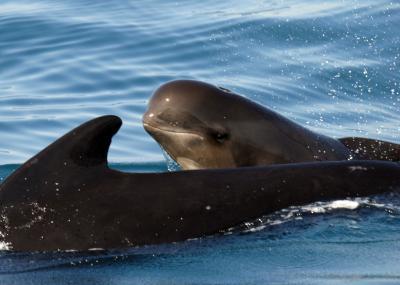An international team of scientists have observed the behaviour of various groups of cetaceans in the Strait of Gibraltar and Cape Breton in Canada belonging to the Globicephala melas species, which are also known as long-finned pilot whales. These results show that these whales use synchronised swimming when they identify the presence of an external threat.
There are 300 pilot whales inhabiting the Straight of Gibraltar. Here these cetaceans remain throughout the entire year in the water of the Mediterranean and the Atlantic. But, little is known about their social structure.
Headed by the University of Aberdeen (United Kingdom) in collaboration with the Doñana Biological Station (CSIC) and Conservation, Information and Study on Cetaceans (CIRCE) group, the study analysed the patterns of association between individuals within this whale community. The aim was to provide a long-term vision of their social system.
"The important point is that we compared two different populations: one inhabiting the Strait of Gibraltar which is exposed to predators (boats in this case) and another with an ecotype where there are not so many boats (Cape Breton in Canada). The pilot whales are social species and we were interested in seeing how mothers teach their young, for example. We observed that they use synchronised swimming when in danger," as explained to SINC Renaud de Stephanis, researcher of the Biological Station of Doñana and coauthor of the study published in the journal Behavioural Processes.
Between 1999 and 2006 the scientists gathered samples in an area of 23,004 km in the Strait of Gibraltar and took 4,887 images of the dorsal fins of whales to compare them with those in Canada.
"They swim in complete synchrony both in the Strait of Gibraltar and Canada. When sea traffic or whale watching vessels are nearby, the whole group collectively reacts to such external stimuli. When we arrived at the watching area they were swimming at their normal rhythm but after 10 or 15 minutes near to them, the mothers and their young began to swim in a synchronised manner in alert position. This is a sign of affiliation to the group," adds the expert.
According to the researcher, these cetaceans also have a social structure formed by permanent partnerships. This means that they spend their life with the same whales and they do not interchange between different groups, as in the case of bottlenose dolphins.
Thanks to the study we now know that the presence of vessels also disturbs diving behaviour. "As such, when we began observing the whales up close, they tended to spend quite some time on the surface. However, the longer we spent nearby, the longer they stayed under water. This behavioural change could affect their energy levels, since they then have to make more of an effort to protect themselves and their young. In turn this limits hunting time, which means that they cannot feed their young properly," concludes the researcher.

Pilot whales use synchronized swimming when they sense danger.
(Photo Credit: Renaud de Stephanis)

Pilot whales use synchronized swimming when they sense danger.
(Photo Credit: SINC)
Source: FECYT - Spanish Foundation for Science and Technology